 |
 |
 |
| |
Tipranavir - Phenotypic protease inhibitor resistance in the clinic from 2006 to 2008: available treatment options
|
| |
| |
Reported by Jules Levin
18th Intl HIV Drug Resistance Workshop
June 9-12 Sunny Ft Myers Florida
David Hall1, Joseph Scherer2, Myriam Witvrouw3, Agnes Paquet4, Eoin Coakley4, Richard Bethell3
1Boehringer Ingelheim Pharmaceuticals, Connecticut, USA; 2Boehringer Ingelheim Germany, Ingelheim, Germany; 3Boehringer Ingelheim (Canada) Ltd, Laval, Quebec, Canada; 4Monogram Biosciences, California, USA
ABSTRACT
Background: current guidelines recommend that resistance testing should be performed when considering a change to the treatment regimens of protease
experienced patients. To explore their available options, the database of matched genotypic and phenotypic test results from HIV clinical isolates at Monogram Biosciences was queried for the years 2006-2008. Phenotypic results
were analyzed to see how many patients could consider the second generation protease inhibitors (PIs), darunavir (DRV) and tipranavir (TPV) treatment, based on phenotypic results.
Materials and methods: The analysis set included 7775 results for the Monogram Biosciences PhenoSense GT. Results were categorized according to their upper and lower clinical cut-offs as resistant (R), partially susceptible
(PS), or susceptible (S) to ritonavir-boosted DRV, lopinavir, saquinavir, atazanavir, and fosamprenavir. Selection criteria were specimens collected 2006-2008 and at least one of these 5 PIs not S. For TPV, the susceptible range was further divided to consider hypersusceptibility, defined as those with Ic50 Fold change (Fc) <0.5.
Results: There were 4.9% (378) of results that were R for all 6 PIs and 31.0% (2407) that were not R to any of the PIs. TPV was an available option for 98% of those with no R for the other PIs, 92.5% of those R to one PI, 85.3% R to 2 PIs, 74.0% to 3 PIs, 49.6% to 4 PIs and 32.5% to all 5 PIs. When considering those R to the other 4 PIs, the percentage R for DRV increased from 21.2% in 2006, to
33.0% in 2007, to 41.9% in 2008. R for TPV was constant, range 53.9% to 57.3%. Among the 40.9% of results that were S for at least 3 of the other PIs, 9.6% had TPV Fc <0.5.
Conclusions: Based on phenotypic testing 95% of patients had at least one PI option available. The second generation profile for TPV is supported by susceptibility observed in 32.5% of those resistant to all 4 first generation PIs and DRV. When multiple PIs are available, differences in position in the PS range will be important.
INTRODUCTION
Decisions about the next regimen to use for an antiretroviral therapy experienced HIV-1 infected patient are based on "resistance" tests, which may be genotypic sequencing of the viral population circulating in the peripheral blood or may be in vitro testing of the phenotypic resistance to candidate drugs. A database of test results for clinical isolates sent for both genotypic and phenotypic testing can be examined to see what resistance patterns are being observed and how those patterns are changing over time.
Monogram Biosciences offers a PhenoSense GT assay conducting both phenotype and genotype resistance testing. The database of results from this testing offers an opportunity to look at what drugs are available for patients
considering a change in therapy.
When considering second generation protease inhibitors, evaluation based on phenotypic testing is attractive because there are a number of competing interpretive algorithms for evaluation of genotypic results and the complex patterns of mutations in treatment-experienced patients are hard to evaluate with any of the algorithms.
METHODS
Population: Patients with clinical isolates tested for phenotype and genotype 2006-2008.
· Sent to Monogram Biosciences and successfully producing results for both tests.
· not participating in a clinical trial.
· observing a phenotypic result above the lower clinical cut-off (LCO) for at least one of atazanavir, darunavir, fosamprenavir, lopinavir, and saquinavir.
Population was interrogated to look at patterns of resistance in the four most popular 1st generation protease inhibitors: atazanavir, fosamprenavir, lopinavir, and saquinavir. Along with patterns of resistance and cross-resistance with the two 2nd generation protease inhibitors: darunavir and tipranavir.
Phenotypic outcomes were categorized according to the Lco and the upper clinical cut-off (uco) established by Monogram Biosciences on the basis of clinical data.1
· Below the LCO indicates a fully responsive susceptible (S) virus.
· Between the LCO and the uco indicates a partially responsive, partially susceptible (PS) virus.
· Above the UCO indicates a non-responsive resistant (R) virus.
With tipranavir the LCO is 2 fold change (Fc) and the UCO is 8 Fc. In investigating possible hypersusceptibility, the cut-off of 0.5 Fc was applied. Monogram Biosciences
defines hypersusceptibility at 0.4 FC.
Results are reported descriptively as rates and proportions.
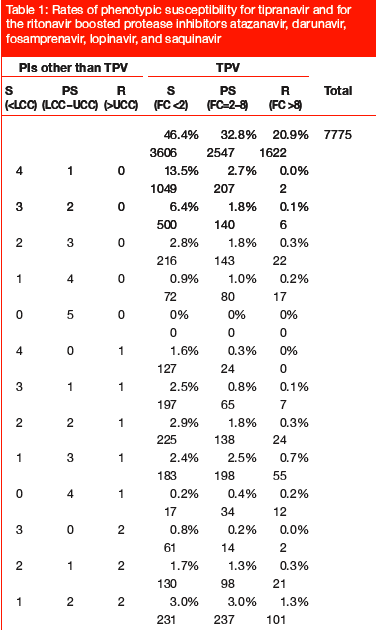
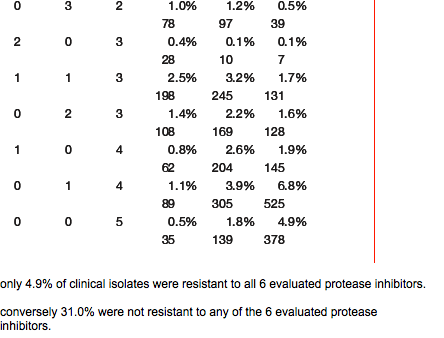
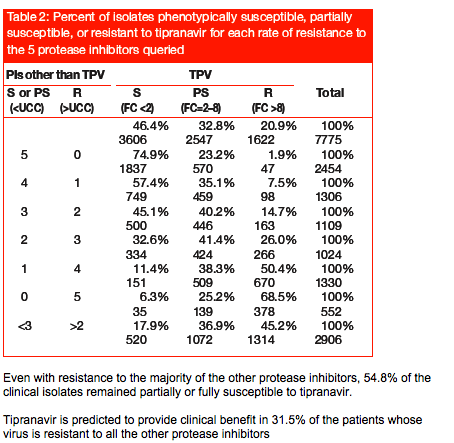
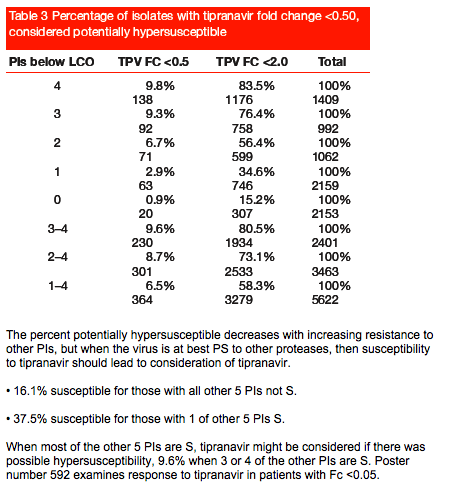

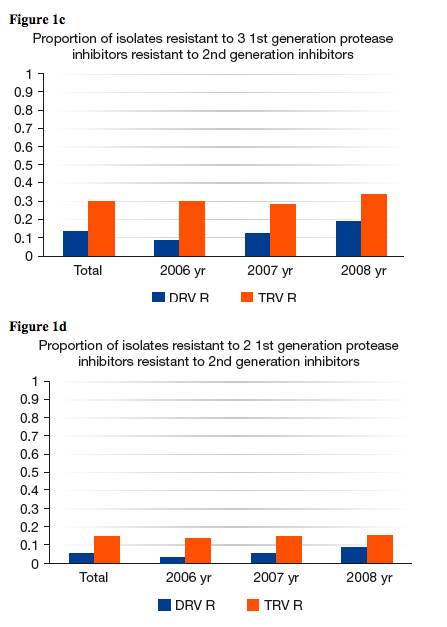
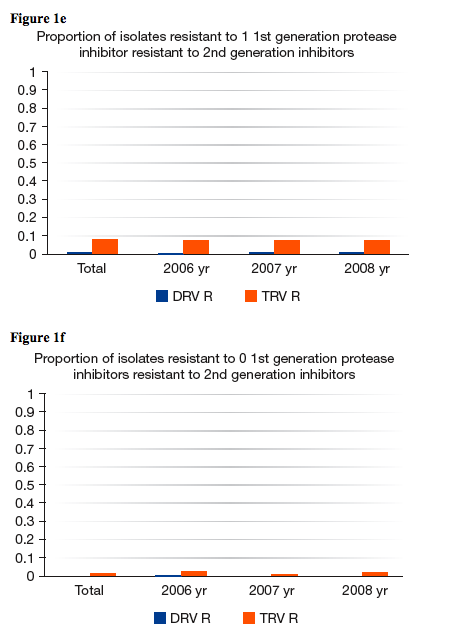
AUTHOR DISCUSSION
At least one protease inhibitor remains an option for treatment of 95% of patients seeking resistance testing.
Even with resistance to the majority of the other protease inhibitors, 54.8% of the clinical isolates remained partially or fully susceptible to tipranavir. Susceptibility or partial susceptibility was observed in 31.5% of those resistant to all 4 first generation PIs and DRV.
Tipranavir could be chosen as the next protease inhibitor in a regimen when it is potentially hypersusceptible (Fc <0.5). The poster: Phenotypic Resistance and Response to Tipranavir, evidence for Hypersusceptibility by JD Baxter J Schapiro, cAB Boucher, J Scherer, R Bethell, M Witvrouw, c Tilke, DB
Hallexamines response to Tipranavir in patients with Fc <0.05.
Tipranavir's resistance profile contrasts from 1st generation PIs and darunavir, leading to a clearly defined subgroup of patients for whom it would be the PI to choose based on resistance.
References
1. Defining the upper and Lower Phenotypic clinical cut-offs for Darunavir/Ritonavir by the PhenoSense Assay. coakley E, chappey c, Benhamida J, Picchio G, de Bethune MP. 14th conference on Retroviruses and opportunistic Infections. 2007.
2. JD Baxter, J Schapiro, cAB Boucher, J Scherer, R Bethell, M Witvrouw, c Tilke, DB Hall. Phenotypic Resistance and Response to Tipranavir, evidence for Hypersusceptibility. XVIII International HIV Drug Resistance Workshop, 2009.
Acknowledgement
Supported by Boehringer Ingelheim Pharmaceuticals.
|
| |
|
 |
 |
|
|